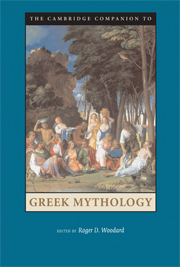Book contents
- Frontmatter
- Introduction: Muthoi in Continuity and Variation
- Part I Sources and Interpretations
- 1 Lyric and Greek Myth
- 2 Homer and Greek Myth
- 3 Hesiod and Greek Myth
- 4 Tragedy and Greek Myth
- 5 Myth in Aristophanes
- 6 Plato Philomythos
- 7 Hellenistic Mythographers
- Part II Response, Integration, Representation
- Part III Reception
- Bibliography
- Index
3 - Hesiod and Greek Myth
from Part I - Sources and Interpretations
Published online by Cambridge University Press: 28 March 2009
- Frontmatter
- Introduction: Muthoi in Continuity and Variation
- Part I Sources and Interpretations
- 1 Lyric and Greek Myth
- 2 Homer and Greek Myth
- 3 Hesiod and Greek Myth
- 4 Tragedy and Greek Myth
- 5 Myth in Aristophanes
- 6 Plato Philomythos
- 7 Hellenistic Mythographers
- Part II Response, Integration, Representation
- Part III Reception
- Bibliography
- Index
Summary
For the goats of Nahunta’s hill,
My sometime Muses unawares.
Introduction
Writing in the second century BC, the Roman playwright Lucius Accius advanced the case - as reported, though disapprovingly, by Aulus Gellius in his Attic Nights 3.11.3-5 - that Hesiod’s work had preceded that of Homer. Accius based his argument on what he deemed to be certain Homeric assumptions predicated upon Hesiodic revelation. Modern scholarship, while commonly assigning Hesiod to Homer’s eighth century BC, more typically - though not universally - reverses Accius' relative chronological ordering.
Whether it be something approaching a real-world life description or, as a number of scholars are now more inclined to advocate, only the construction of a literary persona, a biographic sketch of the poet named Hesiod has emerged from antiquity - chiefly gleaned from the works attributed to him. His father is said to have been a native of the Aeolian port city of Cyme on the northwest coast of Asia Minor. Economic deprivation led the father to resettle in Greece - in the Boeotian village of Ascra, lying in Mt. Helicon’s Valley of the Muses - the place that Hesiod would call home. The poet Hesiod presents himself as a herder and farmer - indeed, he tells that it was while he shepherded his flock on the slopes of Mt. Helicon that the Muses came to him and first inspired him with poetic art.
- Type
- Chapter
- Information
- The Cambridge Companion to Greek Mythology , pp. 83 - 165Publisher: Cambridge University PressPrint publication year: 2007
- 2
- Cited by



